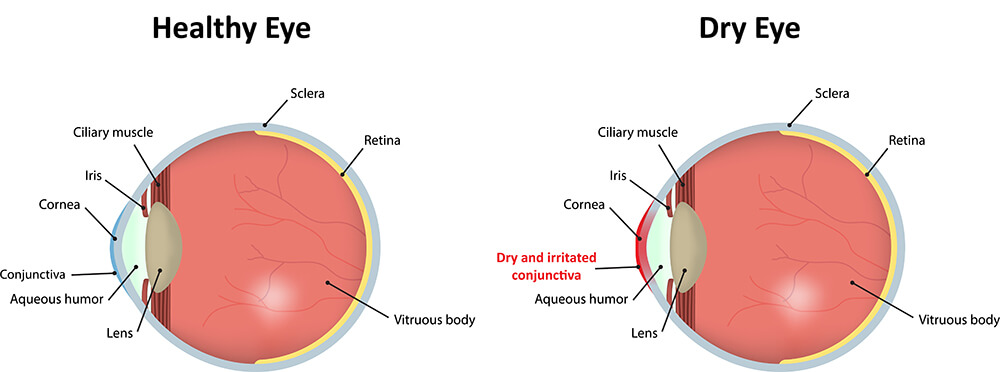Home | Dry Eyes
Dry Eyes
What is Dry Eye?
Millions of people suffer from dry eyes, which is a condition related to the tear film system in the eye. Dry eyes occur when the eyes do not produce enough tears, or they do not produce high-quality tears to keep the eyes moist.
It may start off as a temporary acute problem, but it can become a chronic condition for many patients. If not treated properly, dry eye can progress and permanently impact how you see.
What Are The Symptoms Of Dry Eyes?
Common symptoms of dry eye include:
- Scratchy feeling in the eye
- Feeling that there is a foreign body in the eye
- Stinging or burning sensation
- Eye redness
- Blurry vision
- Contact lens discomfort
- Eye pain
- Excessive tearing
- Mucous buildup around the eye
The Tear Film System
To understand dry eye, it’s important to know some basics about the tear film system. The tear film has three layers that cover and protect the eye:
- The outer oily (lipid) layer is produced by the meibomian glands. It prevents the watery layer from draining too quickly
- The middle (aqueous) layer is produced by the lacrimal glands. It is watery and nourishes the eye with water-soluble proteins.
- The inner (mucin) layer spreads the watery layer over the entire eye
What Causes Dry Eye?
There are many things that can cause dry eye. Finding the most effective treatment depends on what’s causing dry eye syndrome to occur. Patients who have frequent uncomfortable symptoms of dry eye should have a thorough eye examination and evaluation.
The eye may not be producing enough tears. There are a variety of reasons for that, including:
- The natural aging process
- Side effects of many medications including antihistamines, beta-blockers, and antidepressants
- Rheumatoid arthritis, Sjogren’s syndrome, and other autoimmune disorders
- Not blinking enough when looking at the TV or electronic devices.
- Complications of LASIK
The tear film may be evaporating quickly due to environmental factors or certain health disorders:
- Exposure to windy, smoky, or dry environments
- Meibomian Gland Dysfunction
- Blepharitis (inflammation of the eyelids)
- Rosacea
How Can My Eye Doctor Determine What Is Causing My Dry Eye Symptoms?
There are special tests that your doctor can perform to test dry eye symptoms. These include measuring the volume and quality of tears, as well as how long it takes the eye to make tears.
- Exploring possible environmental factors
- Administering the Schirmer test to see whether the eyes are making enough tears
- Inserting eye drops containing dye so that the doctor can measure how long it takes for tears to dry
- Evaluating the meibomian glands by pressing on the glands of the eyelid to see if the oil is being secreted normally
What Are The Treatments For Dry Eye?
The good news for patients is that a lot of research is being conducted, and new types of treatment become available every year.
For mild dry eye symptoms, you can try making some simple lifestyle changes or using non-prescription treatments:
- Applying a warm washcloth over the eyes several times a day
- Inserting over the counter artificial teardrops
- Using artificial tear gels and ointments at bedtime
- Cleaning with eyelid scrubs may reduce bacteria that cause blepharitis
- Blinking often and taking short breaks every 20 minutes when reading and using the computer
- Consulting with your doctor about changing medications to reduce side effects.
- Adding Omega-3 fatty acids to the diet
Medical options for more serious or chronic dry eye symptoms:
If you live in south Florida and you feel as though you may be suffering from dry eye syndrome you may seek to have your eyes tested. Your eye doctor will ask you a series of questions about your lifestyle, work and home environments, work requirements, and even nutrition habits so that they can begin to make a general assessment. Often we will measure your tear volume or tear production using one of several tests. These tests may include the “Schimers Tear Test” which a strip is placed under your eyelids to see how much tears are absorbed. Other tests include a series of dyes to determine the surface conditions of your eyes and to determine how long it takes for your eyes to evaporate the tears. These tests determine the degree of dryness and the location of the dryness on the eyes.






